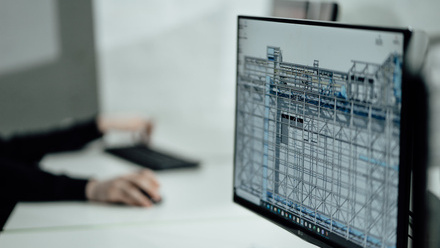Mind the AI gap
Artificial intelligence (AI) promises to bring strategic benefits to architectural firms, improving decision-making, increasing project efficiencies and enhancing client experiences. Yet, scaling up and unlocking the full potential of any emerging technology can prove difficult. Drawing on lessons learned deploying technology solutions to some of the world's leading players in the sector, this article explains how architectural and design practices can avoid common AI minefields to achieve greater return on investment.
In the wake of the coronavirus pandemic, construction projects are still being impacted by labour and materials shortages, causing continued budget and time overruns. As organisations progress digital transformation to gain a competitive edge, the inexorable rise of artificial intelligence (AI) and machine learning (ML) in the architecture, engineering and construction sector shows no sign of slowing. Offering firms new ways to accelerate and improve decision-making, efficiency and customer service, two thirds of companies plan to invest more in AI over the next three years.
These new technologies offer unprecedented capabilities for architectural practices to improve decision making, automate calculations and test design variations to fast-track client projects. The new ability – to quickly analyse data, identify patterns and make informed decisions with minimal human intervention – is set to transform how firms operate. Released from time-consuming tasks such as workflow and resource planning, Architectural Technology professionals can spend more time on billable work and business development activities.
As well as boosting productivity through workflow and scheduling automation, there is also a role for AI to inform designs and plans, aid materials selection and improve the way multi-disciplinary teams translate these plans into completed structures. With increased use of drones by construction teams and growing adoption of advanced cameras by site workers, AI can easily knit together captured images and videos into usable 3D-reality models, floor plans and site maps. The technology can be successfully used to compare those images and models to create design versus realtiy visualisations and rapidly identify deviations. Advanced analytics accelerate and improve decision making, with ability to run millions of permutations of how a project schedule and costs will be affected to ensure the right course of action is taken and minimise risks and delays.
Moving beyond individual structures, AI can also be deployed successfully at large scale developments to enhance urban planning and highlight sustainability opportunities. AI-driven tools can be used to analyse and optimise factors such as views, daylight, traffic movements, parking and more. To improve human comfort and energy efficiency, tools can model wind movements between buildings, predict sound levels from traffic and identify contributory factors causing heat islands.
Hidden pitfalls
However, although many architectural and construction firms are achieving successful results from these kind of AI deployments, scaling up enterprise-wide remains unattainable for many – particularly when complex multi-disciplinary supply chains are taken into account. All too often, AI expansion often reveals underlying problems.
AI projects frequently over-run, overspend and fall short in terms of results. The most common constraints to scaling up are:
- Legacy infrastructure issues
Huge AI processing requirements swamp data centre and network capacity, causing latency issues or even outages. Trying to share actionable insights with stakeholders in multiple locations can reveal further weaknesses in legacy IT infrastructures, which haven't been designed to share such datasets securely at speed and scale. Frequently, this leads to poor user experiences and collaboration challenges. - Unforeseen costs
New technologies are stretching IT budgets. Total cost of ownership (TCO) does not stop with acquiring the AI solution itself, of course; it also includes implementing and maintaining the right IT infrastructure and integration systems to support long-term AI deployment. - Internal resource and skills gaps
To optimise AI workloads and allow an organisation to realise its potential business benefits, specialist IT skills are required. Most architectural practices are not able to employ and retain large, multi-skilled IT teams, or devote adequate resources to ensure long-term AI success.
Boosting chances of AI success
Architectural firms are increasingly moving to the cloud to satisfy these extra IT infrastructure requirements. Many companies use a combination of cloud and on-premise platforms to give them the agility and scalability they need for high loads, without the need to own and maintain unused capabilities during quieter times. Research shows that the businesses enjoying the biggest gains from AI are taking greater advantage of cloud infrastructure than their peers.
With the added pressure AI brings to in-house IT teams, many organisations quickly realise that trying to achieve this perfect mix of infrastructure, resources and skills on-site and maintain a cloud estate is simply not feasible.
Infrastructure-as-a-Service (IaaS) provides a cost-effective, robust foundation for AI growth. Providing on-demand access to computing power and storage via the cloud, it allows firms to overcome legacy issues, while offloading hardware costs, upgrade burdens and skilled resourcing requirements to a managed service provider (MSP). This route quickly pays back with savings on data centre space, infrastructure, licensing, support, training and headcount, providing a fully-managed service in a predictable, monthly OpEx model.
Choosing the right AI partner
Here are five key questions to ask to ensure you choose the right MSP to ensure AI success:
- Do they have a strong track record in architecture, engineering and construction and can help you meet industry and regulatory requirements?
- Can you retain necessary data and workloads on-site, while accessing the latest technologies across public, private and hybrid cloud environments?
- Can they evidence expertise to deploy the right IaaS solution with ongoing management, optimisation and UK-based 24/7 support?
- Do they have expertise in high-performance graphics processing units (GPUs) capable of handling vast and complex workloads simultaneously, which are essential for rapid AI and real-time business analysis?
- Do they have end-to-end expertise from devices, connectivity and cloud to storage, security and UX?
IaaS solutions are empowering organisations across many sectors with more effective handling of complex AI workloads and headache-free management. With pandemic challenges still lingering, this route is helping architecture and design practices to stay ahead of the competition, providing new flexibility, speed and scalability on a realistic budget and time frame. The leading architecture firms are increasingly leveraging as-a-Service models to unlock greater ROI from new technologies. This trend is accelerating digital transformation across the sector and enabling IT leaders to unlock greater strategic benefit.
This article first appeared in AT Journal issue 144






